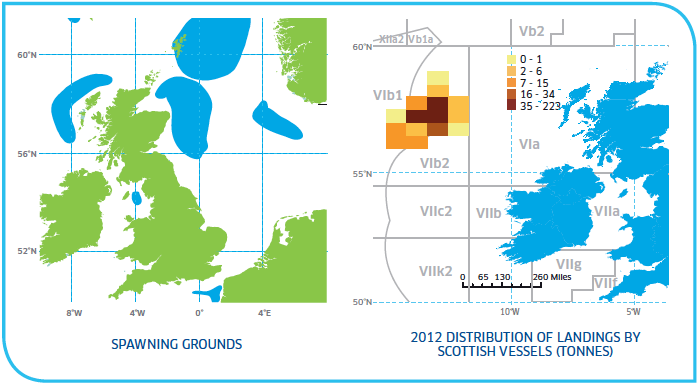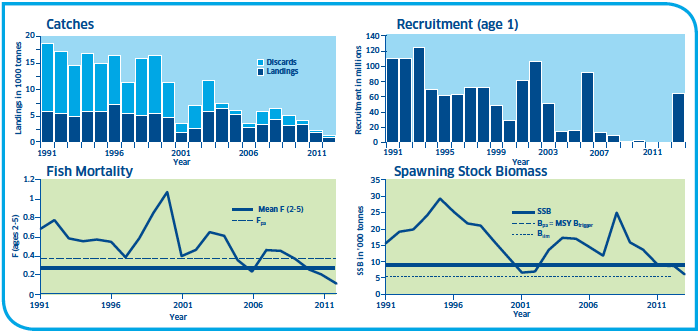Revised editon: Fish and Shellfish Stocks: 2014 Edition
Information on the state of fish and shellfish stocks of commercial importance to the Scottish fleet, inclduing Total Allowable Catches (TACs) for each stock.
Haddock Stocks - Rockall (VIb, XII and XIV)
Rockall haddock (Melanogrammus aeglefinus), by weight, is the most abundant demersal species landed from this area. It is exploited by two main fleets: Russian vessels deploying small mesh nets (40-70 mm), and the European fleet using demersal trawl gear with a cod-end mesh of 120 mm and above.
2014 position : UK share 976 tonnes
Last Year : 798 tonnes
Landed into Scotland in 2012 : 572 tonnes
Value for 2012 : £945,669
Biology
Haddock are distributed throughout the Rockall Bank area and can be found at depths down to 600m, although they are mainly concentrated in the 150 to 300m depth range. Juvenile haddock are mainly found in the shallower waters of the central Bank, at depths less than 180m. There is strong evidence to suggest that Rockall haddock form a separate stock from those found on the continental shelf of the British Isles. The northward flowing surface current between Rockall and the Hebrides may act as a barrier preventing eggs and larvae reaching Rockall from the east or southeast. This hypothesis is supported by tagging studies showing that no haddock tagged from other stocks have been recovered from Rockall.
The haddock found on the Bank have much slower growth rates and a smaller size at age than haddock from other areas. Sampling information by MSS observers has also shown that over 80% of Rockall haddock are sexually mature at age 2. The first spawning of a newly matured female produces around 80,000 eggs, with this number increasing as the fish gets older. Spawning takes place between March and May, with the eggs being released in batches. The eggs and larvae are distributed in the upper water column, and drift north-easterly. Once the juveniles reach 5-10 cm in length they gradually migrate and settle on the sea bottom.
Rockall haddock eat a variety of foods, preferring benthic organisms, with fish and detritus becoming an increasing part of the diet during periods of large stock size. The fish feed preferentially during the summer and autumn, putting on weight until the spawning period when the intensity of feeding significantly decreases.

ICES Advice on Management
Information Source: ICES advice 2013 http://www.ices.dk/sites/pub/Publication%20Reports/Advice/2013/2013/had-rock.pdf
Quoted text in italics.

MSY and precautionary approach reference points
| Type | Value | |
|---|---|---|
| MSY Approach | M S Y Btrigger | 9,000 t |
| FMSY | 0.3 | |
| Precautionary Approach | Blim | 6,000 t |
| Bpa | 9,000 t | |
| Flim | Not defined | |
| Fpa | 0.4 |
State of stock and advice
- Fishing mortality has decreased over time and for 2012 was estimated at 0.1328 this means that nearly 13%, by number, of all fish between 2 and 5 years of age were caught.
- The spawning stock biomass has increased in recent years and has been above Bpa (and MSY Btrigger) since 2003. For 2013 it was estimated to be around 6,224 tonnes.
- Fishing mortality and biomass are below and above, respectively, the precautionary approach limits and the level which is consistent with achieving maximum sustainable yield ( F2011< FMSY).
ICES advises on the basis of the MSY approach that catches should be no more than 1620 t in 2014. If discard rates (at age) do not change from the average of the last seven years (2006-2012), this implies landings of no more than 980 t. Further management measures should be introduced to reduce catches of small haddock and to protect the incoming recruitment in 2013.
A management plan is under development and was evaluated by ICES in 2013. ICES concluded that a maximum F value of 0.2 in the HCR was required to ensure consistency with the precautionary approach under the low recruitment conditions observed since 2004.
The assessment is an update of last year's assessment. Fishing mortality in 2011 has been revised upward by 85%, and SSB in 2012 has been revised downward by 13%, when compared with last year's assessment.
Management outcomes for 2014
In April 2014 at the Council of Ministers meeting in Brussels, the EU Total Allowable Catch for Rockall (VIb, XII and XIV) haddock was set at 1,210 tonnes, with the UK quota for 2014 at 976 tonnes.
Contact
There is a problem
Thanks for your feedback